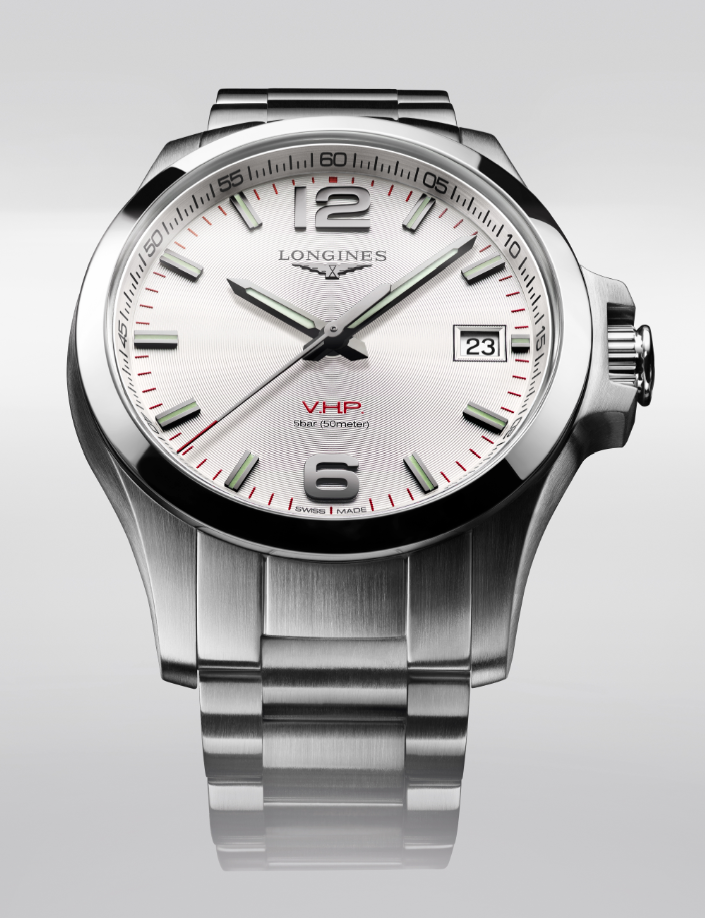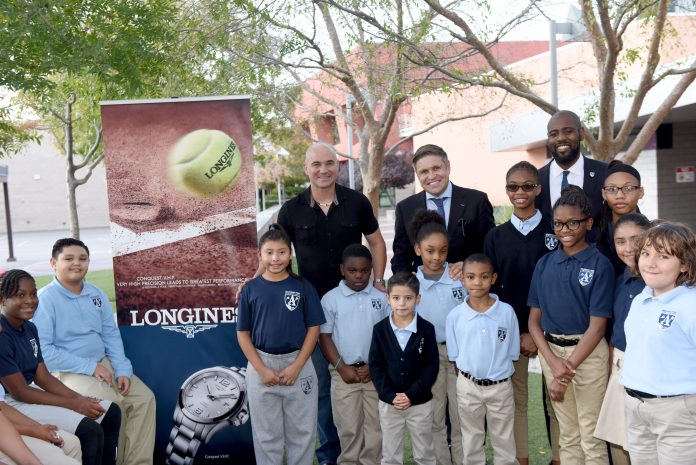Andre Agassi does relatively few endorsements but for 10 years he’s had a multi-faceted endorsement program with Longines watches. See below for Andre’s watch of preference, the Conquest VHP. Courtesy of Longines, Inside Tennis went to Las Vegas to visit his groundbreaking school. Here’s our report:
LAS VEGAS –
Far from the fancy steakhouses and big-stakes craps tables, far from the snazzy shows and alpha male cigar parlors – out in the hardscrabble East Las Vegas outback, there was a dusty, windblown plot.
Empty and ordinary, it was destined to give birth to a tennis player’s special vision. Then again, Andre Agassi is hardly ordinary. How many tennis players have gone from being a whiskey-swigging frosted flake, known for a vapid “Image Is Everything” slogan, to a Streisand-loving, Steffi-seeking, Mandela-meeting author who surprised us with sports’ most revealing autobiography, en route to becoming an inspired philanthropist, tirelessly raising $185 million to empower thousands of inner-city kids who were being kicked in the gut by a once considerable system that had gone amuck?
Agassi collected eight Grand Slam trophies, was No. 1, and he won both an Olympic gold and the hand of the most eligible fraulein in sports – Steffi (whoops, make that Stefanie) Graf.
And on a benign Friday afternoon I’m making a pilgrimage to check out Agassi’s greatest trophy, the East Vegas K-1-12 prep school he created.
Just off the freeway, I enter a scruffy, video poker world – a spare, brick and mortar commercial neighborhood of chain link fences and unadorned adobe walls. There the no-frills Happy Pizza joint is not far from the Nevada Pic-A-Part outlet, the C & O Thrift Store and the less-than-famous Masterpiece Barber Shop.
At Agassi’s modern, but far from pretentious burgundy and beige Democracy Prep masterpiece, we’re hardly wooed by stately quads or tall towers. And here’s a twist: the school – which teaches Korean, fencing and tae kwon do – doesn’t even offer tennis. Still, as I enter Democracy Prep, I’m stunned. It’s not that it’s silent. But I detect an almost serene meditative feel. I sense a focus. You could call it purpose. Sure, backpacks abound. There are guys with dreadlocks. Varsity hopefuls shoot hoops, a football player talks about how good he is at returning kickoffs – go Blue Knights. Youthful energy abounds.
But I ask, “Where’s the chaos? Where are the bad-mouthing clusters of rival cliques and a mean circle or two of gossiping gals? And where’s the clutter? Goodness, how come this place is so immaculate?” It’s truly spotless.
How can this be? Punk Agassi was one of the most problematic, pain-in-the-butt, “rebel without a cause” figures that sports ever imposed on us. Never mind “West Side Story” or “Blackboard Jungle,” tennis’ answer to James Dean drank in his tennis academy room, skipped classes and broke into the girls’ dorm. Picking fights and setting fires were his thing. Here was a tortured kid with a red three-inch pinky nail and a pink mohawk. Ivan Lendl once called him “a forehand and a haircut.” He could have dubbed him “a forehand and an F.” That’s what Andre regularly got in school, well, until he dropped out in ninth grade.
Not surprisingly, he also came close to dropping out of tennis, until he had an epiphany. After a bad loss in Stuttgart, his coach Brad Gilbert grabbed a beer and barked, “Enough already, buddy. We’re not leaving this room until you decide. Either you change your ways or just give it all up, because this sure isn’t working.”
Andre pivoted. He brought a new focus to his tennis and launched his implausible journey of giving. The once flaky kid created a foundation in 2001 and became a sage. When he finally retired, at 36 in 2006, he offered the most poignant retirement speech tennis fans had ever heard and then his recollections brought half of the men’s locker room to tears.
But Agassi was about far more than words. For 16 years, he tirelessly organized a dazzling, A-list (“Hollywood say howdy to Vegas”) fundraiser. His “Wow, I can get a tennis lesson from Steffi and Andre for only 60 grand” fundraisers emptied both tear ducts and deep pockets. One night, casino mogul Kerk Kerkorian gave $1.25 million. In 2000, Agassi discovered the future site of his tuition-free academy. Standing in a school corridor under scores of college banners, Andre told me that the East Vegas plot “was once just a piece of dirt. We had a vision to impact kids. We didn’t know exactly what it would look like. Then it just grew into its own animal. There wasn’t a specific objective, except that ‘more was better’ – meaning how many kids can get a better education.”
Everyone knows American education is in a world of hurt. Only 7% of low income kids graduate from college, and Andre stepped in to do something about it. Wise teachers were hired. Eager students arrived and the school now has 1,150 pupils. Word spread, the waiting list was long. Hope transforms – inspiration matters.
But there were problems. It’s not only that charter schools are a live-wire source of controversy. Critics claim they drain resources from public schools. Protests and placards emerged. More to the point, Andre soon realized that schools are messy propositions. Yes, his academy was adeptly educating kids, yet from the outset there were missteps and money headaches. But Andre refused to be a victim. Many tennis greats, from Gussy Moran and Althea Gibson to Bjorn Borg and the once-wealthy Boris Becker – have fallen into bankruptcy and even squalor. But savvy Agassi worked hard to become a financial savant. As we strolled through the tranquil school, Andre recalled the turmoil of 2008: “I had about $50 million in our portfolio, a $40 million debt on the campus and we were running about $5.5 million a year in expenditures.”
Andre once wrote that when he was young, the toughest ten minutes of his day came just before he went to sleep, when he tortured himself with scathing self-criticism. So I asked him, “What was it like to lay in bed knowing you had that debt hanging over you?”
He replied, “I always joked that Ambien was no match for a $40 million mortgage. But I was going to get things done one way or another.”
Ya think?
Instead of taking sleeping pills, he dared to enter the daunting world of hedge funds and high finance. “I’m never scared of asking dumb questions,” he quipped. Now he references financial lingo with ease – capital influx, buy backs, viable models and education funds. In a feat greater than returning a Pete Sampras serve, he partnered with the adept social impact money manager Bobby Turner to create a fund which on a wide scale could replicate Andre’s Vegas success by getting the likes of Citibank, Merrill Lynch, the University of Michigan and many a rich individual to invest in the operation of charter schools. And by using the metrics of bonds, the debt market and the tax code they would earn 9-10% annually and in three years could lease back the schools which would now have reduced mortgages – whew. “All of our operators,” Agassi reported, “are return customers. The [investment] model has been acid-bath tested.”
Agassi approached hundreds of possible backers, telling them that once charter schools are built public money pours in. But teachers unions bristled. The Chinese government embraced his model and wanted to go all in, but despite their being “generational thinkers,” Andre didn’t want them to control his fund. All the while, $185 million poured in. Incredibly, he now has opened 79 schools across America.
Some have been critical of hedge funds being involved in education. But Andre noted, “Ten years after being $40 million in debt we have no debt, we have raised over $100 million [and] are running far more efficiently. And that we have opened over 70 schools is an estimate of just how far we’ve come. I’m pretty proud…We’ve deployed nearly $1 billion with a billion to go.”
Unfortunately, notes Andre, “for all the schools we’ve built, it’s just a drop in the bucket. And that tells you the scale of this issue. But as long as our country is failing our next generation, there’s going to be a demand for the high quality education that we’re doing our best to provide.”
Knowing that he was neither an educator nor an operator, but rather a facilitator (and that his school was paid for in perpetude,) Agassi sold his Agassi College Preparatory School last year to the Harlem-based charter group Democracy Prep.
Still, on campus, Agassi’s presence is felt. In a brief ceremony, one of Andre’s greatest backers, Juan Carlos Capelli, who heads the fashion watch company Longines, thanked Andre “for making this such a beautiful place. Elegance is not about fashion or beauty. It’s a real attitude.” Later, students offered celebratory fist-pumps and a ten-year old girl fearlessly ran up to Andre and offered a hug. “Mr. Agassi, I have admired you for so long,” she gushed. Kayla, a ninth grader who moved from Detroit just to go to the school, told me, “It’s an inspiration that Andre built something so amazing for kids and their families that are struggling.”
The school abounds with symbols. Doves fly by. Students gather around what’s dubbed the “Hope Tree.” The school’s defining structure is its innovative graduation bridge which students can walk over only when they matriculate.
A huge photo of Nelson Mandela offers his assertion, “To be free is not only to cast off one’s chains, but to live in a way that respects and enhances the freedom of others.”
Martin Luther King informs students, “The ultimate measure of a man is not where he stands in moments of comfort and convenience, but where he stands at times of challenge and controversy.”
Everywhere there’s evidence of a 7:00 am to 3:30 pm culture of aspiration and accountability, which, Andre asserts, is “what allows dreams to come true.” Ties in place, khakis clean, expressions happy – the kids here seem so bright, so present.
Somewhere, near the intersection of two corridors named Excellence Lane and Academic Road, Winston Churchill reminds the Vegas kids, “Never give in. Never give in – never, never, never, never.”
Andre and I stroll past the school’s small lawns and over its asymmetrical paths and chat about the mystery of Jimmy Connors and the struggles of Milos Raonic. Andre celebrates the baseline brilliance of his intense new pupil Novak Djokovic, who, “like any artist puts more pressure on himself than anyone else,” and predicts that the Serb should do well next year.
Then on a nearby wall, I spot the classic William Ernest Henley quote: “I am the master of my fate; I am the captain of my soul.” I reflect on Andre’s fate and remind the ninth-grade dropout that after his father left Iran he arrived in Chicago with only $13. Now Andre is involved with a billion-dollar fund. I then ask him what it felt like when, at last, he realized that his school was fully endowed. “It was a fingerprint of my story,” he notes with a quiet but unmistakable pride. “It was a journey of choices. My lack of choices led me to provide choices for all these kids who might not have had them otherwise. Having you here is also somehow part of that journey. It’s all part of the same life we’ve lived and part of the same story.”
And I think, there are few other stories like that of a certain bald baseliner, a dreamer with a forehand and a vision – a vision for kids.




















